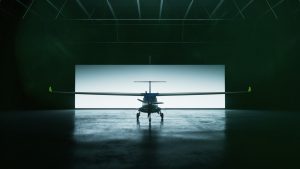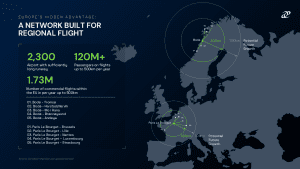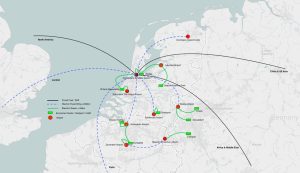Policy Perspectives on the Future of Regional and Business Air Mobility in the Netherlands
Published by the Dutch Business Aviation Association (DBAA) – Policy Insights Series
As part of DBAA’s ongoing work to support a sustainable, innovative, and accessible aviation ecosystem in the Netherlands and Europe.
 Electric aviation is emerging as one of the most transformative developments in the transition toward sustainable mobility. The first generation of battery-electric aircraft, such as the Vaeridion Microliner—a nine-passenger aircraft designed for short-haul operations—is expected to enter service around 2030. This shift will have profound implications for connectivity, environmental performance, and aviation policy in the Netherlands and across Europe.
Electric aviation is emerging as one of the most transformative developments in the transition toward sustainable mobility. The first generation of battery-electric aircraft, such as the Vaeridion Microliner—a nine-passenger aircraft designed for short-haul operations—is expected to enter service around 2030. This shift will have profound implications for connectivity, environmental performance, and aviation policy in the Netherlands and across Europe.
For Dutch policymakers and regulators, the rise of electric aviation represents both a challenge and an opportunity: a chance to strengthen the country’s international accessibility while achieving climate goals and revitalizing regional infrastructure.
A Pathway to Net Zero
Electric aircraft can operate with zero emissions when powered by renewable energy, eliminating CO₂ and nitrogen oxides. This aligns directly with the Netherlands’ Klimaatakkoord (National Climate Agreement) and the Fit for 55 objectives under the European Green Deal.
Battery-electric aircraft are also exceptionally efficient. Unlike road transport, flight paths are direct and friction-free, and unlike high-speed rail, electric aircraft require minimal supporting infrastructure. The system-wide environmental benefits make electric aviation a strong contributor to the Netherlands’ broader decarbonization and sustainable transport ambitions.
The Expanding Electric Aircraft Landscape
The Vaeridion Microliner is just one example of a rapidly growing family of electric and hybrid-electric aircraft expected to be operational by 2030–2035.
- Heart Aerospace (Sweden) – Developing the ES-30, a 30-seat hybrid-electric regional aircraft with an all-electric range of about 200 km and a hybrid-assisted range of up to 400 km. Type certification is targeted around 2030.
- Eviation (USA) – Creator of the Alice, a nine-seat all-electric commuter aircraft that successfully completed its maiden flight in 2022 and is expected to enter commercial service around 2027.
- ZeroAvia (UK/USA) – A pioneer in hydrogen-electric propulsion, with its ZA600 system for 9- to 19-seat aircraft expected to be certified in 2025–2026, followed by larger systems for regional jets later in the decade.
- Conscious Aerospace (Netherlands) – A Dutch developer focusing on hydrogen-electric propulsion systems for regional aircraft, including the planned conversion of the Fokker 100 to hydrogen flight. Based at Rotterdam The Hague Airport, Conscious Aerospace aims to conduct its first hydrogen-powered test flight in 2028, contributing directly to the Netherlands’ ambition to lead Europe’s clean aviation transition.
- Horizon Aircraft (Canada) – Developing the Cavorite X7, an electric VTOL (eVTOL) aircraft exploring hydrogen-electric options, targeting service entry in the early 2030s.
- Airbus ZEROe – Exploring three hydrogen-powered aircraft concepts for commercial service by 2035, marking a major step toward large-scale zero-emission aviation in Europe.
This new generation of aircraft will reshape regional connectivity. Routes such as Amsterdam–Münster, Rotterdam–Bremen, or Eindhoven–Brussels—currently underserved or uneconomical with fossil-fuel aircraft—will become viable, sustainable, and cost-competitive alternatives to ground transport.

Courtesy of Vaeridion
A New Policy Role for Dutch Regional Airports
The Netherlands’ aviation landscape is heavily concentrated around Schiphol, where environmental constraints and slot scarcity limit growth. Smaller airports such as Rotterdam The Hague, Eindhoven, Lelystad, Groningen-Eelde, and Maastricht Aachen now stand at a strategic crossroads.
With the arrival of zero-emission electric aircraft, these airports can be repositioned as green regional mobility hubs—supporting distributed air networks that reduce road congestion, stimulate regional economies, and align with the Luchtvaartnota 2020–2050 (Civil Aviation Policy Memorandum).

It would be counterproductive, from both an environmental and mobility standpoint, to restrict or close smaller airports under the assumption that they contribute to pollution. On the contrary, such infrastructure will be essential to enable the most sustainable form of air transport available.
Investments in on-site solar generation, battery storage, and electric ground operations can turn these airports into self-sustaining facilities. The integration of renewable energy ecosystems into airport management aligns with national objectives for circular economy and energy transition.
Economic Efficiency and Market Transformation
Electric aviation is not just cleaner—it is also cheaper. Electricity costs up to 80% less than jet fuel, and electric propulsion systems require 40% less maintenance. This cost reduction enables affordable regional air travel, with ticket prices between €150 and €300 for journeys of 300–400 km, comparable to rail fares.
This will allow Dutch and European travelers to reconnect regional centers efficiently, improving accessibility for business and labor markets while easing pressure on overburdened road and rail systems.
Strategic Opportunities for Dutch Business Aviation
The Netherlands, with its innovative business aviation sector and dense network of regional airports, is particularly well placed to pioneer electric aviation. The initial generation of aircraft—light, efficient, and seating up to 30 passengers—will enter service well before major airlines can deploy large electric fleets.
Business aviation operators, FBOs, and charter providers are ideally positioned to adopt and demonstrate these technologies. Aircraft such as the Vaeridion Microliner, Heart ES-30, and Eviation Alice fall within existing operational frameworks for business aviation and can be integrated without extensive regulatory overhaul.
As slot constraints and environmental limits at Schiphol intensify, electric business aviation offers a practical and sustainable alternative for short-haul connectivity, relieving main-hub pressure while maintaining access to essential routes.
Policy and Regulatory Recommendations
To realize these opportunities, Dutch and European policymakers should:
- Facilitate Certification and Airworthiness: Support the EASA and ILT in accelerating approval processes for electric and hydrogen-electric aircraft while maintaining rigorous safety standards.
- Support Airport Infrastructure Readiness: Establish co-funding schemes (e.g., via the Nationaal Groeifonds or EU CEF) for charging stations, hydrogen refueling, and on-site energy storage.
- Incentivize Zero-Emission Operations: Introduce lower landing fees, ATC charges, and noise quota benefits for zero-emission aircraft movements.
- Integrate Air Mobility into Climate and Transport Policy: Recognize electric and hydrogen aviation as part of the Netherlands’ sustainable transport ecosystem, alongside rail, EVs, and inland shipping.
- Encourage Regional Cooperation: Coordinate development of electric routes and infrastructure with neighboring countries under EU TEN-T and Single European Sky frameworks.
A Call to Action
The electrification of aviation is no longer a future vision—it is a policy priority. The Netherlands, as a frontrunner in sustainability and technology, can play a pivotal role in shaping Europe’s zero-emission air mobility framework.
By modernizing regulation, investing in green airport infrastructure, and promoting early adoption through business and regional aviation, the Netherlands can ensure that its aviation sector remains innovative, accessible, and aligned with national and European climate ambitions.
The future of flight is electric—and the Netherlands has every reason to lead the way.
